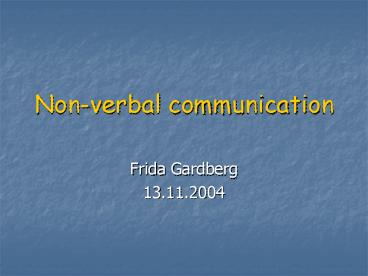Non-verbal communication - PowerPoint PPT Presentation
1 / 11
Title:
Non-verbal communication
Description:
in communication with others only 30 % of the communication is verbal, 70 ... PROXEMICS. how people use personal space; to keep someone at the right distance ... – PowerPoint PPT presentation
Number of Views:216
Avg rating:3.0/5.0
Title: Non-verbal communication
1
Non-verbal communication
- Frida Gardberg
- 13.11.2004
2
Non-verbal communication
- Introduction to non-verbal communication
- Comparing verbal and non-verbal communication
- The universal use of non-verbal communication
- Non-verbal codes
3
Introduction to non-verbal communication
- in communication with others only 30 of the
communication is verbal, 70 is non-verbal - non-verbal communication involves gestures,
facial expressions, eye contact - our non-verbal behaviour is mostly subconscious
4
Comparing verbal and non-verbal communication
- both are symbolic, communicate meaning and are
patterned - all societies have different non-verbal languages
- the non-verbal communication is more than just
body language the use of time and personal
space, our voice etc.
5
Comparing verbal and non-verbal communication
- non-verbal communication is learnt through
relations with others - non-verbal behaviours can reinforce, substitute
for or contradict verbal behaviour - we often trust our non-verbal behaviour to reveal
our true feelings
6
The universal use of non-verbal communication
- there is some universality in non-verbal
communication, especially in facial expressions - six basic emotions are communicated by facial
expressions in much the same way in most
societies - happiness, sadness, disgust, fear, anger and
surprise - but what causes the non-verbal behaviours can
vary - there are also variations in the rules for
non-verbal behaviour
7
Non-verbal codes
- PROXEMICS
- how people use personal space to keep someone
at the right distance - contact cultures and non-contact cultures
- KINESIC BEHAVIOUR
- body posture, hand gestures, facial expressions
and eye contact - CHRONEMICS
- the use of time
- M-time (Monochronic) and P-time (Polychronic)
8
Non-verbal codes
- SILENCE
- the use of silence in conversations
- HAPTICS
- the use of touching
- high-touch cultures and low-touch cultures
- VOCAL CUES
- rate, pitch, loudness, articulation, tone,
accent, pronunciation etc. - ARTEFACTS
- things, objects, decorations etc.
9
Conclusion
- misunderstandings can be avoided if we are aware
of and understand our cultural differences - non-verbal communication changes also constantly
10
And always remember
- the more we know of other cultures, the greater
the possibility is of a successful communication!
11
Thank you for listening!































